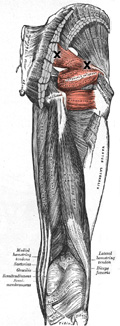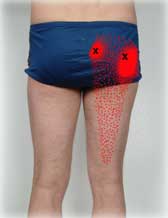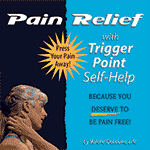
Piriformis Muscle (Excerpt)
...Also Gemelli, Quadratus Femoris, Obturator Internus, and Obturator Externus
Piriformis Sections:
- About the Piriformis
- Common Symptoms
- Causes and Perpetuation of Trigger Points
- Helpful Hints
- Self-Help Techniques
- Applying Pressure
- Stretches
About the Piriformis
 Trigger points in the piriformis are very common, and are usually involved to some extent anytime there is pain in and coming from the gluteal/pelvic region. It is commonly called "piriformis syndrome." Females are affected far more than males, with a ratio of 6:1.
Trigger points in the piriformis are very common, and are usually involved to some extent anytime there is pain in and coming from the gluteal/pelvic region. It is commonly called "piriformis syndrome." Females are affected far more than males, with a ratio of 6:1.
When the piriformis muscle is enlarged, it easily entraps the sciatic nerve and other major nerves and blood vessels. Even if there is entrapment, there are also likely trigger points, which may be part of the cause of the entrapment, since trigger points may cause the muscle to bulge.1 Even though some or all of the sciatic nerve's fibers pass through the piriformis in approximately 11% of patients, Dr.'s Travell and Simons speculated that this may actually prevent entrapment problems, since in their research of surgeries, no surgeons had reported this nerve-muscle variation in any of their patients being operated on for sciatic nerve entrapment.2
Even though the pain referral patterns of the other short lateral hip rotators (the gemelli, quadratus femoris, obturator internus, and obturator externus) have not been distinguished from those of the piriformis,3 I have had a few cases where pain was not relieved until I worked on the obturator internus (over the obturator foramen), so it is always worth considering that the pain may be at least partially coming from one of the other lateral rotators.4
Common Symptoms
- referred pain primarily to the sacroiliac region (the joint where the sacrum and big pelvic bone join), over the buttock, and down the back of the thigh
- in cases of nerve entrapment, the referred pain may extend down all the way to the calf and bottom of the foot, the gluteal muscles may atrophy, the foot may be numb and hard to walk on, and there may be swelling in the leg
- pain is worse with sitting and activity
- entrapment of the pudendal nerve may cause impotence in males and pain with intercourse in females, and pain in the groin or area in front of the anus5
- you may squirm a lot and shift positions trying to get comfortable, and have difficulty crossing one leg over the other knee while seated
- when laying face-up, your foot will rotate out to the side, rather than being in straight alignment6
Trigger Point Images - Piriformis

Causes and Perpetuation of Trigger Points
- reading in bed with your knees bent or otherwise sitting so that the majority of your weight is on your buttocks
- sitting on the floor, especially with your knees bent up in front of you7
- sitting on your foot
- catching yourself from falling, or other sudden muscle overload
- a direct blow to the muscle
- twisting sideways while bending and lifting something heavy
- forceful rotation of your body while your weight is on one leg
- twisting repeatedly while throwing something behind you
- running
- in women, spreading the legs during intercourse
- car accidents, particularly when struck from the driver's side (even for passengers)
- driving for long periods
- a longer second toe
- foot pronation
- one leg shorter than the other
- over-correcting a shorter leg with a lift that is too high
- chronic pelvic inflammatory disease
- infectious sacroiliitis
- arthritis of the hip joint or hip replacement surgery,8 although I believe usually the trigger points likely came first and were untreated for many years9
- the sacroiliac joint out-of-alignment10
Helpful Hints
- I have noticed that patients who end up with hip replacements have had chronically tight piriformis muscles for years. I believe this jams the joint together and causes excessive wear on the ball-and-socket joint. For this reason, I recommend to patients that they not leave piriformis trigger points untreated, so that they don't end up needing surgical intervention.11
- As noted above, far more women have piriformis syndrome than men. I have noticed that women often tense their butt muscles when they are holding onto a lot of anger, and these patients tend to be the ones suffering from trigger points in the piriformis. See the perpetuating factors section for a discussion of emotional factors. You will need to become conscious of tightening the gluteals, and consciously relaxing them repeatedly until you re-train yourself not to tense up. You will need to deal with the underlying factors causing you to hold tension in the buttocks.
- Don't read in bed, sit on the floor, or sit in any other position that puts most of your weight on your buttocks. Sit upright with a lumbar support, so that your hamstrings bear some of your weight.12
- The sacroiliac joint must be treated simultaneously with the piriformis if the joint is a factor.13 See a chiropractor or osteopathic physician to be evaluated for lumbar and sacroiliac joint dysfunction.14
- You may need to see a doctor to rule out a herniated disc.15 Even if you do have disc problems, you will likely benefit from trigger point therapy in order to eliminate all the pain. Acupuncture works very well on herniated and bulging disks.16
- If you feel pain on both sides, you will need an MRI to rule out stenosis of the central canal (narrowing of the hole the spinal cord goes through).17 Acupuncture can help with the pain, but will not affect the stenosis. Surgery may be warranted if the pain is severe enough.18
- Arthritis in the sacroiliac joint, or other types of arthritis may cause trigger points to develop in the piriformis, and may need to be ruled out.19
- Avoid running, and playing tennis, soccer and volleyball until trigger points have been inactivated.20
- Learn to breathe properly if you develop pain deep to the lower edge of the rib cage in the area of the diaphragm after treatment of the piriformis and sacroiliac joint.21 Do the self-help techniques for the diaphragm demonstrated in the following video:
- If you have one leg shorter than the other or a small hemipelvis (the part of the pelvis you sit on), see a specialist for compensating lifts and pads.22 If you have a short big toe and longer second toe, get orthotics to prevent pronation.23
- When sleeping, place a pillow between your legs that goes all the way from the knees to the ankles. Don't bring your legs up to a 90-degree angle.
- Don't drive for long periods without breaks. Get cruise-control so you can move your legs periodically.24 Be sure to use a lumbar support, and try to shift more of your weight to your hamstrings instead of your buttocks by adjusting the seat if possible, or by sitting on a pillow.25
- If you are being advised to have surgery for "piriformis syndrome," be sure to try trigger point therapy and sacroiliac joint release first, as surgery is not likely needed if these are treated first.26
- A note to therapists: as a massage therapist, I was not able to work on the medial external portion of the obturator internus (over the obturator foramen) until I moved the patient over to the edge of the table and dropped their leg over the side. I put a chair with a pillow on it under the lower leg so the leg was bent at about 90-degrees. I was then able to treat the obturator internus by pressing in at about a 45-degree angle.27
Self-Help Techniques
General Guidelines for using these self-help techniques are discussed in detail on the CD-ROM. Click here to order. Please note that you may make the pain worse if you do not follow the proper guidelines as shown on the CD-ROM.
Applying Pressure
- As part of the piriformis self-help, I like to do the muscles the entire length of the spine, because most of the time those muscles are also involved to some extent. Lay face-up on a firm bed or the floor, with your knees bent. Using a tennis ball or racquet ball, start at the shoulder, about one inch out to the side of the spine, and hold pressure eight seconds to one minute per spot. Scoot a small amount to the next spot further down the back, and continue to hold pressure on each spot. Continue until you get to the top of the pelvis. You may want to repeat this on a second line further out from the spine, especially if you have a wide back, or tender points further out. Do not do this directly on the spine! When you get to the lumbar area, most people have enough of a curve that they might need to move to the floor and use a tennis ball or baseball (make sure this is not too hard, and don't use a softball!) You may use your hand to move the ball, searching for trigger points in the lumbar area. Don't press your back onto the ball. If you have been diagnosed with bulging or herniated disks, be very careful not to get too close to the spine!28
 *This video clip not available to demo. Please purchase the CD-ROM to view the full-content of this section.
*This video clip not available to demo. Please purchase the CD-ROM to view the full-content of this section.
- Laying face-up, use a tennis ball on the bed, and search for trigger points in the buttocks area. With your legs bent, work against the edge of the sacrum (the bony triangle between the lumbar spine and the tailbone) and all the way out toward the hip joint in a line about halfway between the top of the pelvis and the bottom curve of the butt. When you get out toward the hip joint (tense your butt muscles and there will be a big dip there), drop your knee out to the side (your knees are still bent!) , and you will know when you have gotten the piriformis!29
Stretches
- Lay face-up, and cross your right foot over the outside of your left knee. Use your right hand to pull down on the right front of your pelvis. Use your left hand to pull down on the right knee toward the floor to assist in a stretch. Inhale and exhale deeply, focusing on relaxing the muscle on the exhale. Repeat on the opposite side.30
- While standing, place your hands on your hips, and rotate your hips around in as full a circle as is comfortable. Then rotate in the opposite direction.31
Also See** (These chapters are available on CD-ROM):
- Gluteus minimus (posterior portion)
- Pelvic floor (levator ani and coccygeus)
- Gluteus maximus
- Gluteus medius
** To view these chapters and more, order the complete text and media set on CD-ROM.
© Copyright Valerie DeLaune, LAc, 2004-2018
| <-- Back to Trapezius Chapter |
- Janet G. Travell , M.D., and David G. Simons, M.D., Myofascial Pain and Dysfunction: The Trigger Point Manual, The Lower Extremities vol. 2 (Baltimore: Williams & Wilkins, 1992), pp. 186-193.
- Travell & Simons, M.D.s, Vol. 2, pg. 203.
- Travell & Simons, M.D.s, Vol. 2, pp. 186-193.
- Author's experience or education
- Travell & Simons, M.D.s, Vol. 2, pp. 186-194.
- Travell & Simons, M.D.s, Vol. 2, pg. 196.
- Author's experience or education
- Travell & Simons, M.D.s, Vol. 2, pp. 195-196.
- Author's experience or education
- Travell & Simons, M.D.s, Vol. 2, pg 193.
- Author's experience or education
- Author's experience or education
- Travell & Simons, M.D.s, Vol. 2, pg. 193.
- Author's experience or education
- Travell & Simons, M.D.s, Vol. 2, pg. 194.
- Author's experience or education
- Travell & Simons, M.D.s, Vol. 2, pg. 195.
- Author's experience or education
- Travell & Simons, M.D.s, Vol. 2, pg. 195.
- Travell & Simons, M.D.s, Vol. 2, pg. 210.
- Travell & Simons, M.D.s, Vol. 2, pg. 205.
- Travell & Simons, M.D.s, Vol. 2, pg. 210.
- Author's experience or education
- Travell & Simons, M.D.s, Vol. 2, pg. 210.
- Author's experience or education
- Travell & Simons, M.D.s, Vol. 2, pg. 209.
- Author's experience or education
- Author's experience or education
- Author's experience or education
- Travell & Simons, M.D.s, Vol. 2, pg. 211.
- Travell & Simons, M.D.s, Vol. 2, pg. 211, with a slight Author's variation

 Piriformis
Piriformis








